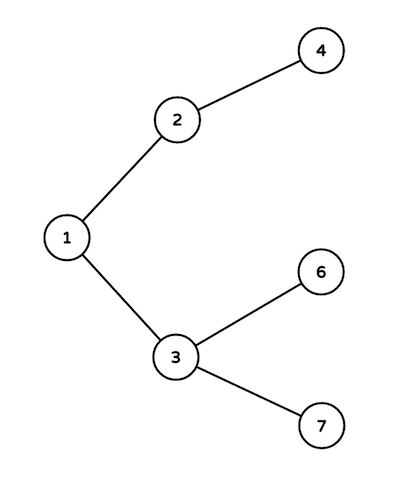7.19
来源:互联网 发布:mysql创建表sql语句 编辑:程序博客网 时间:2024/06/07 11:23
C. Lorenzo Von Matterhorn
time limit per test1 second
memory limit per test256 megabytes
inputstandard input
outputstandard output
Barney lives in NYC. NYC has infinite number of intersections numbered with positive integers starting from 1. There exists a bidirectional road between intersections i and 2i and another road between i and 2i + 1 for every positive integer i. You can clearly see that there exists a unique shortest path between any two intersections.
1. Government makes a new rule. A rule can be denoted by integers v, u and w. As the result of this action, the passing fee of all roads on the shortest path from u to v increases by w dollars.
2. Barney starts moving from some intersection v and goes to intersection u where there's a girl he wants to cuddle (using his fake name Lorenzo Von Matterhorn). He always uses the shortest path (visiting minimum number of intersections or roads) between two intersections.
Government needs your calculations. For each time Barney goes to cuddle a girl, you need to tell the government how much money he should pay (sum of passing fee of all roads he passes).
Input
The first line of input contains a single integer q (1 ≤ q ≤ 1 000).
The next q lines contain the information about the events in chronological order. Each event is described in form 1 v u w if it's an event when government makes a new rule about increasing the passing fee of all roads on the shortest path from u to v by w dollars, or in form 2 v u if it's an event when Barnie goes to cuddle from the intersection v to the intersection u.
1 ≤ v, u ≤ 1018, v ≠ u, 1 ≤ w ≤ 109 states for every description line.
Output
For each event of second type print the sum of passing fee of all roads Barney passes in this event, in one line. Print the answers in chronological order of corresponding events.
Example
input
7
1 3 4 30
1 4 1 2
1 3 6 8
2 4 3
1 6 1 40
2 3 7
2 2 4
output
94
0
32
Note
In the example testcase:
Here are the intersections used:

Intersections on the path are 4, 2 and 1.
Intersections on the path are only 3 and 6.
Intersections on the path are 4, 2, 1 and 3. Passing fee of roads on the path are 32, 32 and 30 in order. So answer equals to 32 + 32 + 30 = 94.
Intersections on the path are 6, 3 and 1.
Intersections on the path are 3 and 7. Passing fee of the road between them is 0.
Intersections on the path are 2 and 4. Passing fee of the road between them is 32 (increased by 30 in the first event and by 2 in the second).
题意:一个二叉树,每个节点不是2*i就是2*i+1
然后有两种操作
(1) 1 操作,开头是1,对于从v到u的道路,所增加的费用为w
(2) 2操作,开头是2,是算出从v到u所需要的过路费并输出
解题思路: 现模拟一颗二叉树的接节点,在用map来找到每个节点所对应 需要的过路费再相加
怎样模拟二叉树的节点?! 对于输入的v,u,因为他们不是偶数就是奇数,又要使他们尽量的往给根节点靠,所以每次轮流使 v/=2,u/=2这样就表面遍历u,v之间的每个节点,在这之前需给每个map赋值即增加的过路费,
算过路费是同样的操作
#include <iostream>#include <queue>#include <map>#include <algorithm>using namespace std;typedef long long int LL;LL Change(LL &v,LL&u){ LL t=v; v=u; u=t;}int main(){ map<LL,LL> Q; int T,s; LL v,u,w,sum; cin>>T; Q.clear(); while (T--) { cin>>s>>v>>u; if (s==1) { cin>>w; while (v!=u) { if (v<u) { Change(v,u); } Q[v]+=w; v/=2; } } else { sum=0; while(v!=u) { if (v<u) { Change(v,u); } sum+=Q[v]; v/=2; } cout<<sum<<endl; } } return 0;}阅读全文
0 0
- 7.19
- 7.19
- 7.19
- 7.19
- 流水账7.19
- 7.19感想
- 7.19 jsp
- 【日志7.19】
- 作业7.19
- 家教日记---7.19.
- 建议7.19 - 建议7.21
- 7.19 mailto <img>
- 7.19学习笔记
- 给7.19的我
- 7.19日牛客网总结
- 安装mysql5.7.19
- 7.19 linux 基本操作
- Linux 配置MYSQL5.7.19
- 关于自定义View简单说明
- Java学习第一天
- 代码审查工具Eclipse插件FindBugs安装使用
- Java数组的基本操作方法整理
- caffe学习(二):利用mnist数据集训练并进行手写数字识别(windows)
- 7.19
- js跳转新页面,指定div加载新页面
- android之在线音乐播放器
- UVa253--Cube painting--骰子涂色--重在算法思想
- pip install geohash后无法import的解决方法
- 显式锁之自旋锁
- 程序安装异常:此项不适合在指定状态下使用
- python---模块与包
- Builder设计模式和AlertDialog的源码分析


